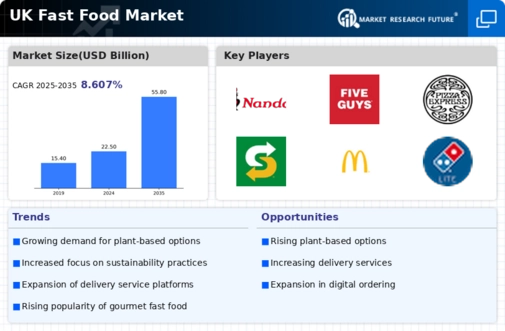Evolving Consumer Preferences
The fast food market in the UK is currently experiencing a shift in consumer preferences, with an increasing demand for diverse menu options. This trend is driven by a growing interest in international cuisines and plant-based alternatives. As consumers become more adventurous, fast food chains are adapting their offerings to include ethnic foods and healthier choices. According to recent data, approximately 30% of consumers express a preference for vegetarian or vegan options, indicating a significant opportunity for growth in this segment. The fast food market must respond to these evolving tastes to remain competitive and relevant.
Regulatory Changes and Compliance
The fast food market in the UK is subject to a range of regulatory frameworks that influence operational practices. Recent changes in food safety regulations and nutritional labeling requirements necessitate that businesses adapt their processes to ensure compliance. These regulations aim to promote public health and transparency, impacting how fast food establishments formulate and market their products. As the industry navigates these evolving standards, companies must invest in training and systems to meet compliance, which could affect operational costs and menu development.
Economic Factors Influencing Spending
Economic conditions play a crucial role in shaping the fast food market in the UK. Fluctuations in disposable income and consumer spending habits directly impact sales. In recent years, the market has seen a rise in value-driven promotions and meal deals, appealing to budget-conscious consumers. Data indicates that during economic downturns, fast food establishments often experience a surge in patronage as individuals seek affordable dining options. This trend suggests that the fast food market must remain agile, adapting pricing strategies to align with economic realities and consumer expectations.
Technological Advancements in Service
The integration of technology within the fast food market is transforming customer experiences. Innovations such as mobile ordering, contactless payments, and self-service kiosks are becoming increasingly prevalent. These advancements not only enhance convenience but also streamline operations, allowing for quicker service. Recent statistics suggest that around 40% of fast food transactions in the UK are now conducted through digital platforms. This shift indicates a growing reliance on technology, compelling businesses to invest in digital infrastructure to meet consumer expectations and improve efficiency.
Increased Competition and Market Saturation
The fast food market in the UK is characterized by intense competition, with numerous players vying for market share. This saturation compels brands to differentiate themselves through unique offerings and marketing strategies. The presence of both established chains and emerging local businesses creates a dynamic landscape where innovation is essential. Recent analyses show that the market is projected to grow at a CAGR of 3.5% over the next five years, indicating that while opportunities exist, the competitive environment will continue to challenge operators to enhance their value propositions.























Leave a Comment